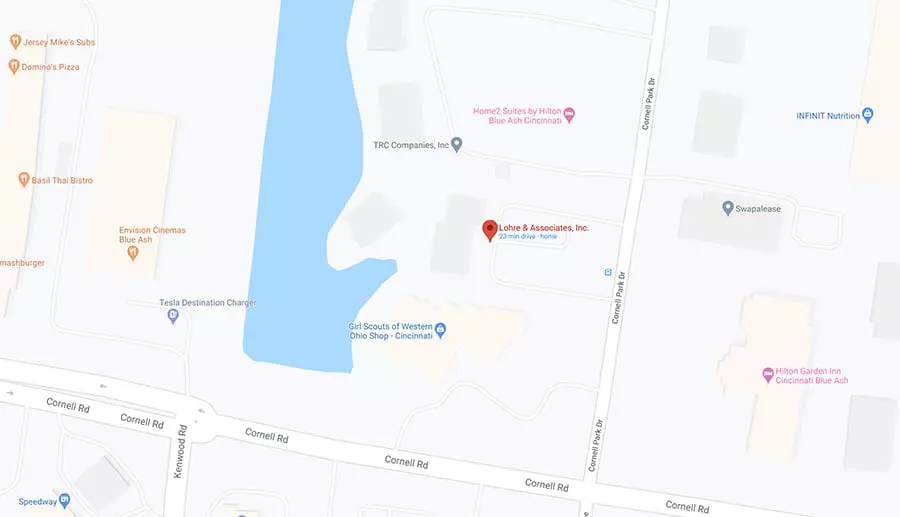Many companies have become concerned with website accessibility over recent years. Since 2018 the drive…

SMPS – CPSM Exam – Industrial Marketing Client & Business Development
Industrial Client and Business Development activity is centered around people you can trust.
The first business development question you need to ask yourself about a potential new client or business relationship is if you can trust them. Trust them to do what they say. Trust them to take you calls. Trust them to champion your relationship with the account. In exchange, you have to act in their best interest. If you want to grow your company, you need to build on your people and the successful work you have done. Everything can lead to another thing, and it’s the best business marketers that uncover those opportunities and nurtures their associates to fill those new needs.
Case Study Activity
This Case Study Activity allows you to reflect on and apply the key concepts that you learned in this Domain to a real-world scenario. Each Domain includes a scenario about the same organization, Gilmore & Associates. The scenario is presented to you, followed by several questions. You can also elect to view the recommended solutions/ responses for each question posed, which are located on the next page. This case study can be studied in many ways:
• You can individually reflect on the questions after reading the scenario, and write your own notes/responses to each question. You can then check your ability to apply the key concepts against the recommended solutions/responses.
• You can pull together a small group and use this scenario to drive a discussion around the challenge and to discuss solutions as a group.
• You can combine a selection of the case study activities (across the Domains) into a larger scenario-based activity as a part of a professional development event.
Your firm, Gilmore & Associates, has committed to becoming a leader in the construction of high-end retirement homes to meet the needs of a rapidly growing market. The company is well established and highly regarded in your geographical area, but is best known for its work building K-12 school facilities.
As the marketing coordinator, you need to come up with a strategy to leverage your strong relationships in the community to identify a new set of clients in the older adult healthcare industry. This will involve taking advantage of your current network and activities areas to develop a different line of business.
1. What are the two types of performance metrics that you could use to evaluate the success of your staff’s BD efforts?
2. Through your existing network, you’ve identified five local firms as potential clients and received initial introductions. How can you use these budding relationships to gather information on the best way for your firm to enter the retirement community market?
3. One of your BD staff members is becoming close to a decision maker at a prospective client’s company, but the efforts spent on developing the relationship are much greater than those being spent on any other prospective client. What do you need to consider in order to tell whether any eventual work gained with this client is going to be worth the added expense now?
4. Although most of your BD energy is currently directed towards making new relationships in this new market, you don’t want to completely lose touch with clients that your company designed schools for in the past. What steps can you take to maintain a relationship with the clients with whom you want to keep
in contact?
5. Gilmore & Associates implemented a new CRM system just over a year ago, and you notice that many staff members do not feel comfortable using it. Many of them use their own individual systems of relationship tracking, and as a result, the information on the firm’s CRM system is already out of date and is poorly integrated with the other data management systems. What can you do to address this problem and maintain a useful system?
1. What are the two types of performance metrics that you could use to evaluate the success of your staff’s BD efforts?
• Activity-oriented metrics. These include the number of sales calls or contacts made, the number of events attended with prospective clients, the number of research projects performed, etc.
• Results-oriented metrics. These include the number of new contracts written, the number of RFPs received, dollars secured vs dollars sought, etc.
2. Through your existing network, you’ve identified five local firms as potential clients and received initial introductions. How can you use these budding relationships to gather information on the best way for your firm to enter the retirement community market?
• Look for partnering opportunities. If one of those potential clients has a new project on the line that your firm isn’t experienced enough to do alone, you may still have some value that would enhance a competitor’s proposal. By working on the project with them, you gain the experience necessary to later pursue a project on your own.
• Find out who those firms identify as thought leaders in the industry. These are the people whose ideas you may want to study and apply, as appropriate, to your own organization. Collaborating with thought leaders is also a good way to make your firm better known in an industry.
• Conduct a client perception study. Data from perception surveys can show you how your firm is viewed within this market-for instance, whether your services are widely known, or how you compare to the competition. You can also ask about the trends that impact their business and who they view as the leading providers of certain services.
3. One of your BD staff members is becoming close to a decision maker at a prospective client’s company, but the efforts spent on developing the relationship are much greater than those being spent on any other prospective client. What do you need to consider in order to tell whether any eventual work gained with this client is going to be worth the added expense now?
• The decision of whether a client is “worth” the pursuit depends on what your firm’s strategic and marketing goals are, and whether the client is likely to help you to achieve them compared to the level of risk associated with investing in a relationship that might not pay off. The goal is to obtain a high return on investment with the lowest possible risk.
For me, the best indication that you have a real shot is when you meet with the president of a company first and they introduce you to the VP and other managers. It’s their blessing that make all the difference. of course, I’ve courted those presidents for decades. Just wating for them to make their move.
• Since Gilmore & Associates wants to gain experience in a new market, targeted clients will include those in the targeted market who will ultimately be able to bring you into that market. This might include clients who have interesting projects to which you want to attach your name and gain publicity through, those who have multiple projects lined up that you could perform, and those who can recommend you to other potential clients in the same market.
• The client might be risky if they c1lready have an existing long-term relationship with a competing firm, if they have a high turnover rate among their decision makers, or if the company has been involved in any litigation.
4. Although most of your BD energy is currently directed towards making new relationships in this new market, you don’t want to completely lose touch with clients that your company designed schools for in the past. What steps can you take to maintain a relationship with the clients with whom you want to keep in contact?
• Assign a client manager to each account who will be responsible for nurturing and maintaining that relationship.
• Make sure that your past clients are kept up-to-date on any service lines or skills that you add to your repertoire. Social media is one tool for accomplishing this.
• Contact former clients every now and then just to say hello and see how things are going. Use your CRM system to keep track of what is happening in the organization, and in their personal lives.
5. Gilmore & Associates implemented a new CRM system just over a year ago, and you notice that many staff members still do not feel comfortable using it. Many of them use their own individual systems of relationship tracking, and as a result the information on the firm’s CRM system is already out of date and is poorly integrated with the other data management systems. What can you do to address this problem and maintain a useful system?
• Create a document that defines the process for data entry. Each user should know exactly what information they should be tracking, and how to do so.
• Schedule additional, hands-on training sess·ions with each user group. Check in periodically in the months afterward to see if ongoing training is needed to ensure that all users are comfortable with the system.
• Keep track of which user is adding what information. This way, problems with integrity that is isolated to one user can be addressed by providing that user with more training.
• Perform a regular evaluation of the entire system at least once per year to confirm that the data it contains is accurate.
Contents
Domain 3: Client.& Business.Deveiopment
1. Create Business Development (BD) Strategies
1.1 Understand the Entire Sales Process
1.2 Identify Goals Based on Markets, Client Types, and/or Services
1.3 Set Baseline and Sales Performance Metrics and Standards
1.4 Develop Project-Pursuit or Capture Plans
1.5 Focus on Differentiation
1.6 Key Terms
2. Research Prospective Client Industries
2.1 Research Industry Trends
2.1.1 Set the Stage for Effective Research
2.1.2 Consider the Following
2.1.3 Use the Results
2.2 Research Strategic Partners and Influencers
2.2.1 Associations
2.2.2 Joint Ventures
2.2.3 Alliances
2.2.4 Design-Build Partnerships
2.3 Identify Thought Leaders
I thought the tip to ask prospects what thought leaders they follow was a great idea. I’ve never had a client be able to tell me that. Most recently it has been just the general importance of their web site. That is the real thought leader today, but that’s not very inspiring. The second most important thing I hear and judge clients on is quick, personal and sincere response to every inquiry. One client guarantees a reply within two hours.
For me, it’s this SMPS path. The writers and producers of these Domains are the most up to date and documented industrial marketing system I have seen. With multi-million dollar industrial equipment sales, selling is much more like selling a building design and construction than lower priced more emotional decisions taught with the Sandler, P&G or Dale Carnegie Systems.
2.4 Conduct Client Perception Studies
2.5 Key Terms
3. Pre-Qualify a Client
3.1 Develop Client Evaluation Criteria
3.2 Research the Client’s Financial Stability
3.3 Determine Repeat Client Potential
3.4 Determine if the Client Fits With Your Firm’s Culture and Values
3.5 Determine Whether the Client Provides Your Firm With Opportunities for Growth
3.6 Determine Profitability Potential
3.7 Key Terms
4. Pre-Qualify a Project
4.1 Develop Criteria for Project Go/No-Go Decisions
4.1.1 Does the Project Adhere to Your Business/Marketing Plan Objectives?
4.1.2 Can You Differentiate Yourselves to Wire or Win?
4.1.3 What is Your Potential for Meeting Profitability Targets?
4.1.4 Do You Have Relevant Expertise?
4.1.5 Consider the Intangibles
4.2 Conduct Continuous Re-evaluation Throughout the Sales Cycle
4.3 Key Terms
5. Build a Relationship with Prospective Clients
5.1 Understand How Trust is Built
5.2 Understand How to Conduct Warm or Cold Calls
5.3 Execute Access Strategies
5.4 Evaluate the Strength of Your Relationships
5.5 Develop Client-Specific Differentiator Strategies
5.6 Leverage Social media Channels
5.7 Key Terms
6. Maintain a Relationship with Past Clients
6.1 Identify the Clients You Wish to Keep in Contact With
6.2 Develop a Key Account Strategy
6.2.1 Provide Solutions and Reduce Client Hassles
My Dad always told us to say, “I’ll find out,” when you got a question you didn’t know the answer to.
6.2.2 Nurture and Build Business Through Cross-Selling
6.3 Identify a Client Manager for Each Account
6.4 Develop Communication and Outreach Strategies
6.5 Determine How Accounts will be Measured and Tracked
Research, Plan, People, Measure, Report, Improve and Repeat – these themes are repeated over and over in any best practice. For P&G’s sales method, it’s setting a goal and determining the steps to reach it.
Ten years ago, before I knew much about re-positioning, I pitched a simple method,”Quality, Education, Feedback.” I lost the account, the VP of Sales said because that was more tactical and he wanted strategic.
6.5.1 Four Stages of Account Tracking Systems
6.5.2 Identifying Your Needs
6.6 Develop Rewards and Incentives
6.6.1 Managing Conflict
6.7 Obtain Feedback and Update Your BD Plan
6.8 Key Terms
7. Choose, Implement, and Maintain a Customer Relationship Management (CRM) System
7.1 Document Your Goals/Expectations
7.2 Research CRM Tools
7.3 Define the Process for Data Entry
7.4 Implement the System
7.4.1 Provide Implementation Resources and Training
7.5 Maintain the System
7.6 Key Terms
8. Measure Client Satisfaction and Address Gaps in Performance/Results
8.1 Determine Your Objectives ·
8.1.1 Satisfaction
8.1.2 Loyalty
8.1.3 Influence
8.2 Determine the Methodology (Direct vs Indirect)
8.3 Determine the Frequency of Outreach
8.3.1 Firm and Client Impact
8.3.2 Project-Specific Events
8.4 Design the Research Instrument
8.4.1 Interviews
8.4.2 Surveys
8.5 Key Terms




